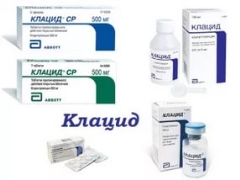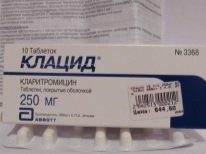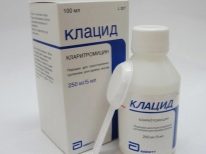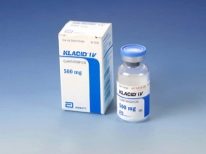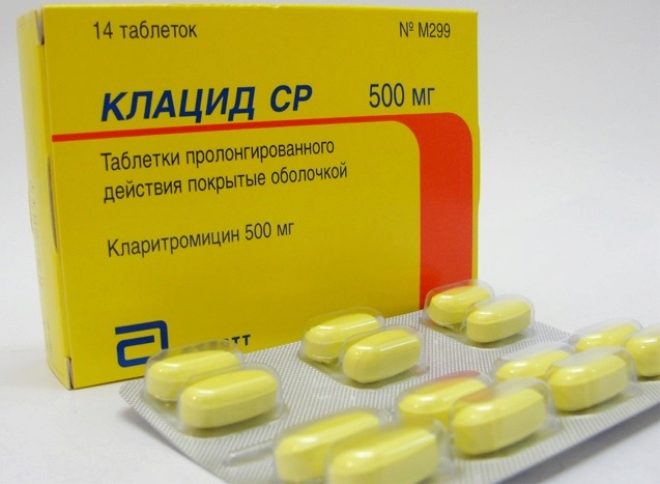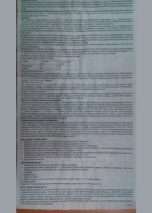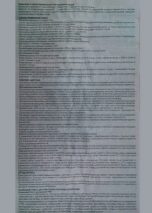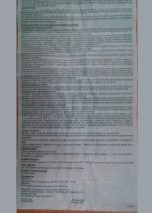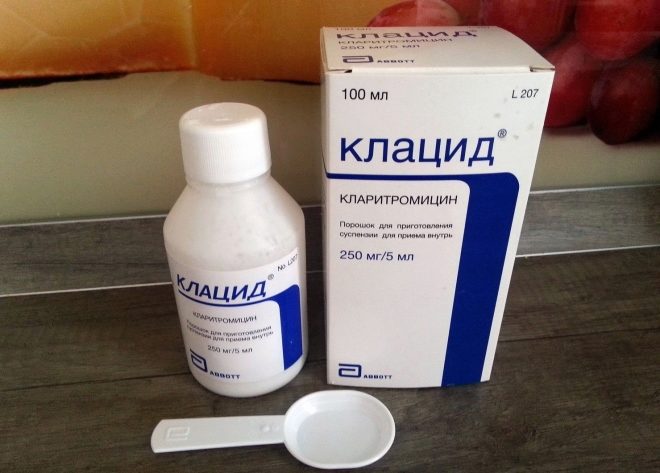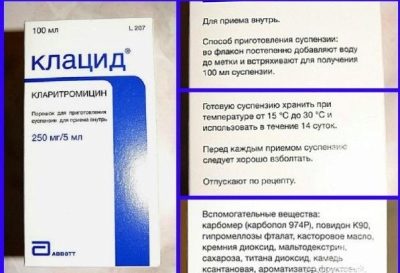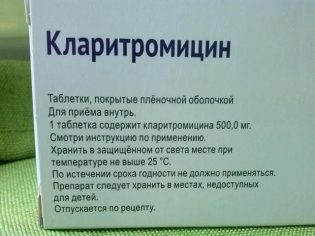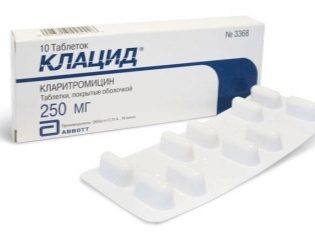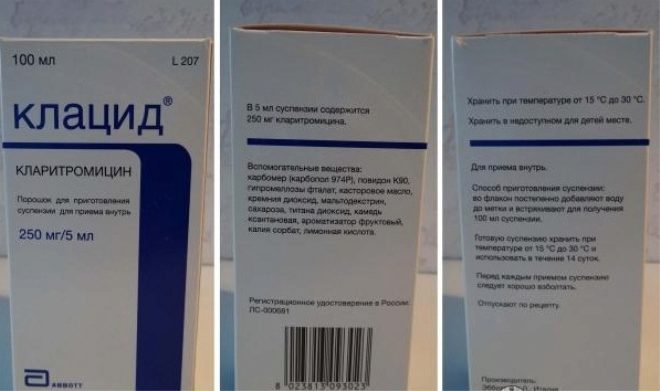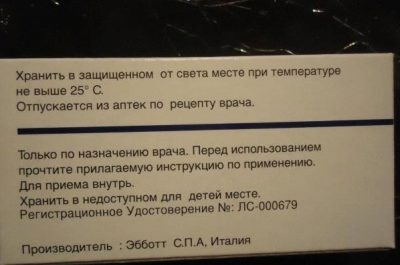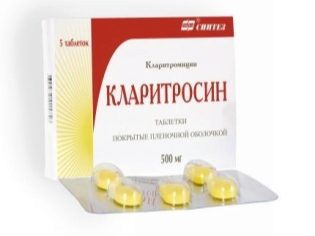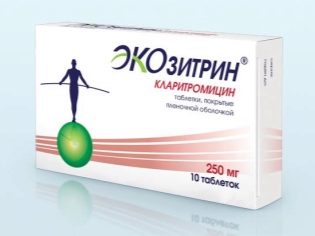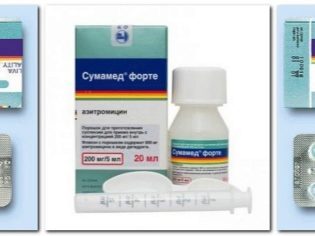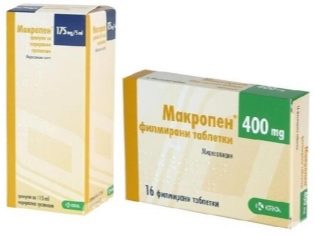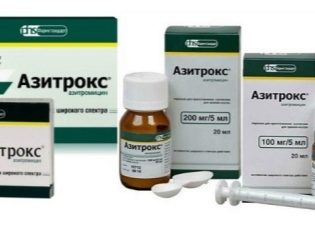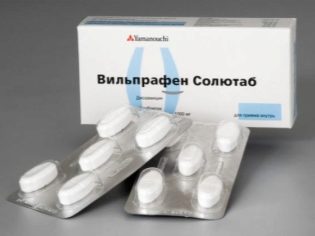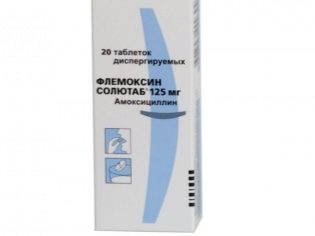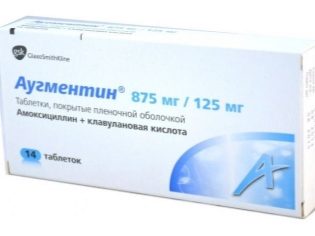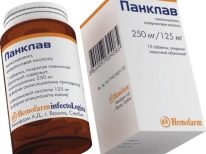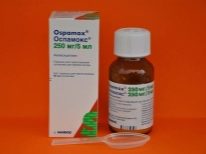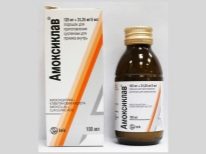Klacid for children
Macrolides are considered one of the most effective and safe antibacterial drugs for children. They are often prescribed for lesions of the respiratory tract by microorganisms and are in demand for otitis, pneumonia, sinusitis or bronchitis. One of the most popular drugs of this group can be called "Klacid". Not everyone knows in what form it is given to children, whether babies are allowed, how to calculate its dose and which analogs can be replaced if necessary.
Release form
Klacid is produced in three different versions:
- Powder for suspension. It is placed in a bottle with a capacity of 60 or 100 ml labeled in the form of a line and is represented by almost white granules with the smell of fruit. After mixing with water, a white opaque liquid is formed from it that smells like fruit. This form is produced in two different dosages, allowing the use of the drug for children of different ages. A plastic spoon or a syringe with tick marks is attached to the bottle to accurately measure the right amount of sweet medicine.
- Pills. They have a yellow shell and an oval shape convex on both sides. Such tablets are also produced in two dosages and packaged in blisters of 7, 10 or 14 pieces. One pack contains from 7 to 42 tablets.
- Lyophilisate for injections. It is represented by white powder with a slight peculiar smell. This tool is placed in hermetically sealed glass bottles, which sell for 1 piece or in a pack of 121 pieces.
Separately produced drug "Klacid CP", presented in the coated tablets with a prolonged exposure. They are characterized by an oval shape and yellow color. Such tablets are sold in packs from 5 to 56 pieces.
Composition
The active component in each form of the drug is clarithromycin. Its dosage in 5 ml of suspension can be 125 mg or 250 mg. Tablets may contain 250 mg or 500 mg of such a substance in each. In the bottle with lyophilisate is 500 mg of the active ingredient. The dosage in “Klacid CP” is also 500 mg per tablet.
Additionally, the medicine includes:
- Sucrose, fruit flavoring, xanthan gum, povidone K90, maltodextrin, potassium sorbate and other substances in the composition of the powder for suspension.
- Talc, hypromellose, microcrystalline cellulose, vanillin, stearic acid, croscarmelose, sorbic acid, and other compounds in tablets.
- Sodium hydroxide and lactobionic acid in injectable form.
- Magnesium stearate, alginate antria, citric acid, macrogol and other components in the drug "Klacid CP".
Operating principle
"Klacid" affects the ribosomes of bacteria, resulting in the synthesis of proteins in microbial cells is suppressed. The drug is usually sensitive:
- Staphylococcus aureus;
- pneumococci and some other streptococci;
- listeria;
- haemophilus sticks;
- gonococci;
- moraccella cataris;
- legionella pneumophila;
- mycoplasma pneumonia;
- chlamydia;
- ureaplasma;
- mycobacteria;
- Helicobacter pylori.
Clostridia, peptococci, whooping cough sticks, bacteroids, Borrelia, Campylobacter and some other microorganisms are destroyed by clarithromycin in laboratory studies.If they are the causative agents of the disease, then “Klacid” should be applied after the sensitivity test to make sure that the medicine will act.
Indications
The medicine is prescribed:
- with bronchitis;
- pharyngitis;
- with pneumonia;
- with sinusitis and other sinusitis;
- with otitis media;
- with laryngitis;
- with tracheitis;
- with folliculitis, impetigo, erysipelas and other skin lesions;
- with mycobacterial infection;
- when infected with chlamydia;
- to eliminate H. pylori and prevent recurrence of peptic ulcer disease;
- with pulpitis, periodontitis and other infections called odontogenic.
The drug is recommended to use only when infected with microorganisms that are sensitive to clarithromycin. When prescribing a medicine for sore throat, whooping cough, scarlet fever and other infectious diseases, it is first desirable to determine if Klacid will act on their pathogen.
At what age is it allowed to take?
The drug in the form of a suspension is not prescribed to newborns and babies up to 6 months, since the safety of the remedies for such small patients has not been established. For children older than 6 months of age, the medicine should be prescribed by a doctor who will evaluate the indications and calculate the desired dosage by weight.
The tablet form is not used for toddlers who have not reached the age of 3, but even for children older than three years, the medication is more often prescribed as a suspension. due to the simpler dosing of liquid medicine. The drug "Klacid SR" is used in the treatment of children over 12 years old, if their weight is more than 40 kg.
Injections are not prescribed for children under 18. They are in demand only for very serious infections or in a situation where it is impossible to take Klacid inside. Such injections are done exclusively intravenously, mixing the lyophilisate with sterile water, and then with glucose or saline. As soon as the patient's condition improves, immediately switch to a suspension or tablets.
Contraindications
The drug is not used for allergies to clarithromycin or another ingredient of a selected form, as well as for intolerance to any other antibiotic that is included in the group of macrolides. In addition, "Klacid" is not prescribed or used under the supervision of a physician:
- severe liver disease;
- with renal failure;
- with hypokalemia;
- porphyria;
- with heart failure;
- with bradycardia or arrhythmias.
Suspension should not be given to patients with isomaltase or sucrase deficiency, as well as glucose-galactose malabsorption or fructose intolerance. In addition, this form is not recommended for children with diabetes.
Side effects
Treatment with Klacid may cause:
- allergic rash;
- insomnia;
- headaches;
- heavy sweating;
- diarrhea;
- nausea;
- pain in the abdomen;
- vomiting;
- taste disorders;
- changes in liver function tests.
Sometimes the drug causes fever, chills, fatigue, discoloration of urine, increased urea or creatinine, leukopenia, liver damage, arrhythmia, nasal bleeding, constipation, muscle pain, loss of appetite, cramps and other symptoms. If they appear in a child, the question of continuing treatment with Klacid should be resolved with the pediatrician.
When taken for a very long time, the bacteria may become insensitive to the drug, which requires the prescription of another antibiotic. Prolonged use of "Klacida" can cause the activation of a fungal infection.
Instructions for use
Suspension
The drug is not available in finished form, so parents need to prepare it for reception on their own. Mix the powder with water immediately before use, because the finished medicine is stored for a certain time.
After opening the bottle, pour in non-carbonated plain water up to the mark, then close the medicine and shake.So, depending on the dosage, 60 ml of a homogeneous white suspension with a content of 125 mg of the active ingredient in 5 ml or 100 ml of suspension containing 250 mg of the active ingredient in 5 ml is obtained.
Before each use of such means it is necessary to shake it, and only then dial with a spoon or a graduated syringe. The drug is given regardless of the diet. If the child does not like the taste of the suspension, you can drink the medicine with juice, water or some other drink. For infants such "Klacid" can be mixed with milk, water or milk mixture.
If an infection in a child is triggered by any microorganism (in addition to mycobacteria), a single dose of the drug is calculated by weight, multiplying 7.5 mg per body weight of a small patient in kilograms. The obtained amount of antibiotic is given twice a day, and the maximum dosage per day for children is 1 g (500 mg twice a day).
For example, a child’s body weight is 20 kg, which means that at one time he needs 7.5 x 20 = 150 mg of clarithromycin (300 mg per day). If a suspension of 125 mg / 5 ml is used, then 1 ml of this product contains 25 mg of the active compound, which means that the baby should be given 6 ml of this “Klacida”. When using a suspension of 250 mg / 5 ml, the child will have to give 3 ml of medication, since 1 ml of this dose contains 50 mg of clarithromycin. In the annotation to the drug also has a table with an approximate single dose with different body weight.
The course of treatment usually lasts 5-10 days and is more accurately determined by the doctor, taking into account both the type of pathogen and the severity of the child’s condition. In some cases, a 5-day suspension is enough to fight the infection, and sometimes the pediatrician, after 10 days of use, continues therapy for up to 14 days (or even up to 21 days).
If the child has contracted mycobacteria, the doctor can increase the dosage to 15 mg per kilogram of patient weight. The drug is taken to eliminate clinical symptoms, often combining with other antibiotics.
Pills
The drug in solid form is taken at any time, regardless of meals. Since the tablets have a shell and should not be bored or chewed, this form is often not prescribed to children weighing up to 40 kg.
If the child weighs 40 kg or more, he is given a tableted “Klacid” in the dosage prescribed for adult patients. The drug is prescribed by 250-500 mg (depending on the disease), twice a day. The drug "Klacid CP" because of the longer action is taken only once a day.
Overdose
High dosage of Klacid disrupts the digestive system, provokes headaches, confusion and requires an immediate response in the form of gastric lavage and the use of sorbents. If the child’s condition has worsened, a doctor should be called in to prescribe symptomatic therapy.
Interaction with other drugs
“Klacid” is not recommended to be combined with many medicines, including: aminoglycoside antibiotics, “Terfenadine”, “Ergotamine”, “Carbamazepine”, “Triazolam”, “Omeprazole, Colchicine, indirect anticoagulants, methylprednisolone, rifampicin, verapamil, and many other medicines. A complete list of them is noted in the annotation to the drug.
Terms of sale
Any form of “Klacida” can be acquired only after submitting a prescription. The average price of a bottle of powder, from which a suspension with an antibiotic concentration of 125 mg / 5 ml is obtained, is 350-380 rubles. For a package of 10 tablets of 250 mg of clarithromycin you need to pay about 600 rubles. Approximately the same is one bottle of injection "Klacida".
Storage conditions and shelf life
Storage of the sealed powder for suspension for the entire shelf life of 2 years is recommended at room temperature in a place hidden from a small child. After mixing with water, the preparation can be stored at a temperature of +15 to +30 degrees for no longer than 14 days.It is not recommended to keep the medication in the refrigerator, and the medicine that has not been used for two weeks should be thrown away.
Tablets and vials for injection should be kept in a place protected from sunlight, where the temperature will not exceed 25 degrees Celsius. The shelf life of the tablet form - 5 years, injectable - 4 years.
Reviews
In the majority of reviews about the treatment of "Klacid" they note the high effectiveness of such an antibiotic. The advantages of the drug mothers include several forms of release, a wide range of antimicrobial effects, a fairly rapid manifestation of the therapeutic effect and a relatively good tolerance in young patients.
For kids, they usually choose a suspension and praise this medicine for its ease of use and sweet taste, about which kids often do not protest. The main disadvantages of "Klacida" parents call its high cost and the presence of contraindications. Often also complain about the side effects of the drug on the digestive tract and nervous system of babies.
Analogs
Replacing "Klacida" can be other drugs with the same active ingredient - for example, "Fromilid, "Ecocitrin", "Clarithromycin"," Klabaks "," Claritrosyn "," Klasine "," Klarbakt "and others. Most of them are available in tablets, but some are also presented in suspension, so there is usually no difficulty in replacing Klacid with a similar medicine.
In addition, the doctor can change "Klacid" to another antibiotic from the group of macrolides and azalides:
- «Macropene». The effect of this antibacterial agent provides midecamycin. The drug is granulated for kids of any age. From it for the little patient prepare a syrup with a banana flavor. Besides, "Macropene"Available in tablets that are prescribed to children weighing more than 30 kg.
- «Azitrox». Such a medicine containing azithromycin is used in the form of a suspension for babies older than six months, and in capsules from the age of 12.
- «Sumamed». The basis of this medication is also azithromycin. The drug in the form of a suspension is discharged from the age of six months, and in the form of dispersible tablets from the age of 3 years.
- «Vilprafen Solutab». These soluble tablets, the active ingredient of which is josamycin, are prescribed to children weighing more than 10 kg.
In some cases, after determining the sensitivity of microorganisms, a pediatrician may recommend an antibacterial agent from another group as a substitute - for example, a cephalosporin antibiotic "Suprax"Or amoxicillin preparations ("Flemoxine Solutab"," Augmentin "," Panklav ","Ospamox», «Amoxiclav" other). So most often come when identifying allergies to "Klacid" or another macrolide.
Rules of treatment with antibiotics will tell Dr. Komarovsky in the video below.
